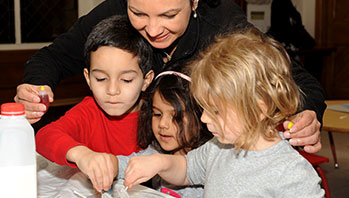- children’s seed collection bags
- egg cartons (one for each child)
- some of the dried fruit seeds used in the week
- seed
MA Standards:
Language/L.PK.MA.6: Use words and phrases acquired through conversations, listening to books read aloud, activities, and play.
Language/L.PK.MA.5.a: Demonstrate understanding of concepts by sorting common objects into categories (e.g., sort objects by color, shape, or texture).
Mathematics/Measurement and Data/PK.MD.MA.3: Sort, categorize, and classify objects by more than one attribute.
Head Start Outcomes:
Logic and Reasoning/Reasoning and Problem Solving: Classifies, compares, and contrasts objects, events, and experiences.
Science Knowledge/Scientific Skills and Method: Observes and discusses common properties, differences, and comparisons among objects.
Science Knowledge/Scientific Skills and Method: Collects, describes, and records information through discussions, drawings, maps, and charts.
PreK Learning Guidelines:
English Language Arts/Language 2: Participate actively in discussions, listen to the ideas of others, and ask and answer relevant questions.
Science and Technology/Inquiry Skills 4: Record observations and share ideas through simple forms of representation such as drawings.
Mathematics/Patterns and Relations 8: Sort, categorize, or classify objects by more than one attribute.
EEC Infant and Toddler Guidelines:
PW44.: The older toddler participates in physical care routines.
PW45.: The older toddler develops self-help skills.
Small Group: Seed Sort

© Commonwealth of Massachusetts, Department of Early Education and Care (Jennifer Waddell photographer). All rights reserved.
STEM Key Concepts: There are many different types of plants and seeds; Seeds hold what a plant needs to make more of itself; People and other animals interact with their environment through their senses
ELA Focus Skills: Compare and Contrast, Sorting, Vocabulary
Safety Tip: Remind children to wash their hands before and after the activity.
Give each child an egg carton. Have them empty the contents of their bags into the top “tray” portion of their carton. Discuss how some of the seeds children collected from outside are very different from the seeds they took out of the fruits. Explain that there are many seeds found in the outdoor environment; they all come from plants, but they may not come from fruits. They may come from pods or other kinds of plant parts. Ask, What kind of plants did some of the seeds you found come from? (trees, flowers, bushes)
- Tell children they are going to sort the seeds in the sections of the egg carton. Help children identify some categories for sorting (size, floats/sinks, color or color pattern, shape, texture). Make a list of these on a chart.
- When you have finished generating and charting ideas for sorting the seeds, reread the list of ideas. Encourage children to work in pairs. Ask them to choose one way to sort the seeds and work together to do it. Then ask them to try another way.
As children sort the seeds, ask questions that encourage them to closely observe, describe, and sort the seeds like:
- Which of these seeds is larger? smaller? wider? narrower?
- What different shapes do you notice in these seeds?
- Which of the seeds feel rough? smooth?
- Is that seed a solid color or does it have a color pattern?
- Are there more darker seeds or lighter seeds?
Reflect and Share
- What type of sorting was easiest to do (by size, shape, texture etc.)? Why do you think so?
- What type of sorting was most difficult? Why do you think so?
- What do you notice about the colors of many of the seeds? Why do you think many of the seeds are dark colors instead of bright colors?
